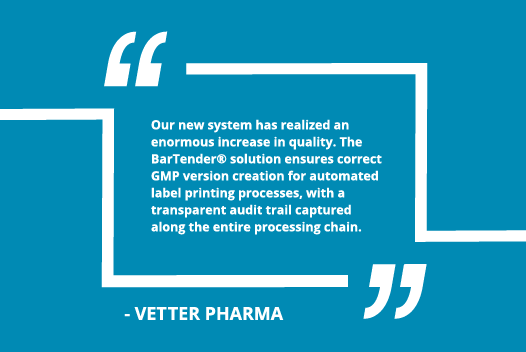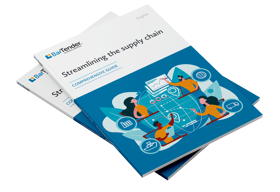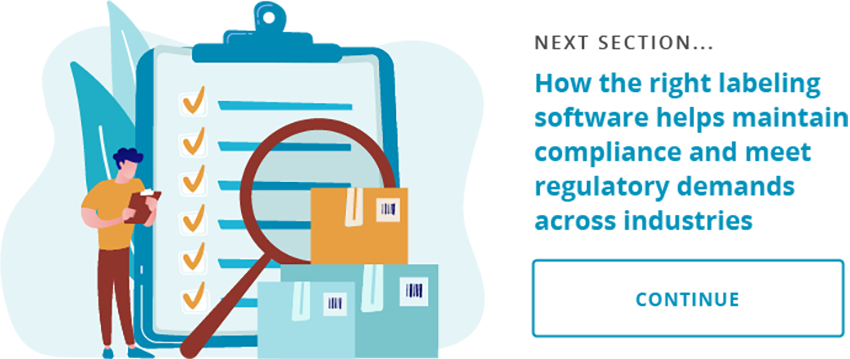As an enterprise organization, your supply chain is probably quite complex, including a vast network of suppliers, manufacturers, logistics and compliance requirements that present labeling challenges at every point. And with so many stakeholders and processes, you can’t afford to rely on manual labeling, data entry and barcode systems to manage your supply chain.
In today’s global economy, the demands from customers, regulatory bodies and industry leaders are setting the trajectory for research and development, marketing, transportation and usage. But if your labeling system isn’t agile enough to keep up, your organization may suffer costly consequences.
While enterprise barcode and labeling challenges exist, implementing an automated, compliant labeling and barcode system can be a game changer, offering solutions that streamline processes, reduce human error and ultimately, offer cost-savings that positively impact your organization’s bottom line.
If you’re considering an automated labeling system or are ready to update to a more robust system, it’s time to take a look at the numerous benefits so you can make a smart, strategic choice when it comes to labeling software for enterprise businesses.
![]()
Reduce IT costs and challenges
Modernizing legacy labeling systems may seem like a daunting task but continuing to use outdated systems, or manual systems, could result in operational disruptions, labeling errors and compliance violations — all of which equate to more costs for your organization.
Added costs associated with ineffective labeling may include:
- Additional labor
- IT resources for troubleshooting
- Relabeling
- Labeling regulation violations
- Cybersecurity issues
- Reliance on too many software programs
One of the biggest challenges enterprise organizations face is labeling compliance and regulations. If a label or barcode isn’t compliant with international regulations and industry standards, it can trigger extensive recalls that require relabeling, redevelopment and reprinting. Not to mention the immense cost of pulling products out of the supply chain and retail market.
With the advent of automated labeling software, change management, compliance issues and operational bottlenecks can be avoided. The following features ensure that correct information is going on the corresponding label, thus avoiding unnecessary costs:
- Version control
- Secure databases
- Label templates
- Integrated data (ERPs such as Oracle WMS or SAP WMS)
- Centralized data
- Custom serialization
Intuitive, user-friendly design
One of the biggest issues facing outdated labeling and barcode systems is lack of intuitive design. Clunky software can take far more time to navigate, leading to slower production and labeling processes that end up costing organizations money.
Using a modern, automated labeling system, that can also scale with your organization as it expands into new markets, offers a number of benefits, including:
- Easier training
- Simple navigation based on Windows interface
- Drag and drop features that enable quick changes
- Compatibility with multiple printer makes and models
- Quickly link data to Oracle databases, SAP systems and other ERPs and WMSs
- Efficient labeling design that can leverage content from numerous sources
- Manages DSCSA and FMD compliance
Consider this example of an apparel retailer who wanted to streamline its labeling process. A combination of issues including suppliers producing their own labels, poor supply chain visibility and inefficient legacy systems were costing the retailer money in relabeling and added training.
By implementing a new standard labeling system for their entire global supplier base, the organization improved interoperability with printers and operating systems, standardized their labeling process and simplified training. With such a large supplier base, it was key that the retailer be able to quickly and efficiently onboard vendors. By creating predefined templates in the software, the retailer was able to quickly begin production and ensure accuracy at every step of the way.
Reduce label errors
Unfortunately, there is significant waste when organizations use manual labeling systems. They may purchase pre-printed label media with their variable data and store it in “label rooms,” but if there’s a change to branding, numbering, ingredients or regulations, that media needs to be discarded. Pre-printed labeling is rife with the opportunity for error.
Additionally, if labeling regulations are violated, it can trigger a long process of recalling products, reprinting and relabeling that can cost organizations millions of dollars to rectify.
Global supply chains rely on labeling accuracy to make sure the right products are getting to the right people with the right information. If that supply chain breaks down due to poor labeling, all stakeholders can be affected.
To avoid costly errors that can affect everything from printing to shipping, an enterprise labeling solution should offer the following features:
- Manage, secure and control data across printing locations
- Proper integration with Oracle systems, SAP systems, other ERP, WMS and more
- Labeling that meets global serialization requirements
- Complies with relevant international and industry regulations such as cGMP, UDI, GS1 Digital Link, allergen labeling requirements such as EU Food Allergen Labeling (FIC), FSMA section 204 and AIAG
- Complete audit trails for compliance and transparency
Reducing label errors is important in a number of industries like medical devices, food and beverage and pharmaceuticals, where it’s crucial that labels maintain compliance to ensure consumer safety.
An example of how automated labeling software can reduce errors in the pharmaceutical industry is present in the case study of Vetter Pharma. They chose BarTender to solve labeling challenges that had the potential to cause errors, including:
- Integration with existing SAP data
- Converting 500 existing label layouts
- GMP-compliant data content for labeling and version creation
- Flexible printer incorporation
- Integration of different numbering and serialization systems
- Integration with Vetter`s bespoke SAP printing program
After implementing BarTender’s labeling and barcode systems, the manager responsible for SAP key user production at Vetter Pharma said:

With that level of accuracy, quality and compliance, organizations like Vetter Pharma can confidently manage their labeling process, meet regulatory requirements such as the Drug Supply Chain Security Act (DSCSA), and foster greater supply chain visibility that decreases errors and provides value for their growing organization.
Standardization and centralization
A lack of standardization and centralization can create several problems during the labeling process, but with centralization, labeling systems can ensure consistent, accurate data is coming from sources of truth before the printing occurs. Such sources include ERPs, WMS, Oracle and SAP databases and Microsoft Dynamics. other proprietary systems.
With proper data management, label changes can be made in a matter of seconds, products can be quickly produced, meet compliance, ship on time and the entire supply chain can be streamlined.
Labeling software like BarTender allows organizations to create and manage standard label formats and serialization schema so that it’s accessible to printers around the world, enabling a lean, “single-source-of-label” strategy.
A unique feature of BarTender is its graphical workflows that help manage production, content and approvals, and offer revision control and greater visibility into the labeling process. Features include:
- Drag-and-drop interface to design custom workflows
- Create workflows for specific file types
- Control access to files at every point in the file’s lifecycle
- Automatic email notifications to specified recipients when a file is moved, edited, printed or altered
- Automated approval requests and notifications
This level of standardization and serialization allows for compliant audit trails and traceability that helps organizations avoid errors and disruptions, and ultimately benefits each stakeholder, including the consumer.
Global change management
Due to the evolving nature of labeling regulations and product information, making changes to a label can be a challenge for enterprise organizations, particularly when dealing with the complexities of a large supply chain.
It’s essential that labeling systems respond quickly to enable accuracy that reliability. If a labeling and barcode system can’t pivot as quickly as changes happen, errors can occur that not only affect costs, but brand credibility and customer satisfaction.
One of the keys to effective change management is making sure that changes are made to the database, not just one part of a system. If your organization uses an SAP database, Oracle database or other ERP, a centralized labeling system offers the ability to make changes, design, and cascade immediately throughout the entire system.
Features like BarTender’s Intelligent Templates™ allow changes to be made to data, format or design and update immediately to the entire system. The label is ready to print immediately, from anywhere in the world. Templates also ensure compliance across all systems, which reduces label maintenance and results in cost savings for large organizations.
Simplified compliance
One of the significant challenges associated with maintaining a global supply chain is remaining compliant even as standards change — and they change often. Additionally, as organizations expand into new markets, they will encounter new labeling regulations and customer demand that may require significant changes to labeling.
With such intricate supply chains that consist of suppliers and manufacturers throughout the world, how do you remain compliant?
The answer lies in an effective labeling solution that offers secure deployment, configurable technology and total accuracy. It also needs to offer immediate changes that comply with various standards and regulations.
Scalability
Some enterprise organizations encounter opportunities to grow, particularly as they develop new products, expand their supply chain and move into new markets. As this growth occurs, labeling management can be tricky, especially if an organization relies on outdated labeling systems or even manual entry.
Manual labeling or barcode systems can be inefficient, inaccurate, costly and even dangerous if a label is incorrectly printed. For example, if a food product contains an allergen but it isn’t listed on the label, not only is it out of compliance, but can lead to a customer having a severe allergic reaction.
To avoid issues associated with poor labeling practices, it’s crucial to choose a dynamic, compliant labeling system that grows with your organization. Features like BarTender’s Intelligent Templates™ automatically manage data that changes from label to label making it simple to scale your label printing.
Additionally, you can easily configure complex printing scenarios by telling templates, layers and even individual objects when to print based on specific web triggers, a single data source or database field or even using multiple conditions. There is no need for coding, which simplifies the process and allows you to scale with ease.
Choosing labeling software that has design and printing capabilities that can integrate with virtually any business system, WMS or ERP will also lend to a streamlined process when you do scale. BarTender integrates with the following:
- Oracle software
- SAP software
- IBM WebSphere
- Sage
- Infor
- HighJump
- Epicor
- Microsoft Dynamics
- “Homegrown” systems
Software like BarTender gives you the flexibility to pivot and change, grow and drive business based on your unique labeling needs, no matter where you’re operating. BarTender integrates with virtually any business system, including labeling software for small businesses to address the unique labeling challenges that come with managing a smaller operation that still needs to adhere to compliance.
Learn more about how labeling software can support supply chain-based businesses
Whether you need a labeling and barcode system for your small organization or a global one, we’re ready to help. Learn more by continuing reading our guide on streamlining supply chain efficiencies, or contact us to speak with a representative about our comprehensive labeling solutions.


